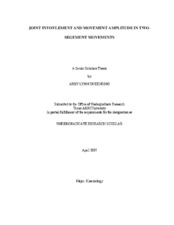JOINT INVOVLEMENT AND MOVEMENT AMPLITUDE IN TWO-SEGEMENT MOVEMENTS
| dc.creator | Dudensing, Abby L. | |
| dc.date.accessioned | 2007-09-17T18:35:27Z | |
| dc.date.available | 2007-09-17T18:35:27Z | |
| dc.date.issued | 2007-09-17 | |
| dc.identifier.uri | https://hdl.handle.net/1969.1/5729 | |
| dc.description.abstract | The purpose of this research is to identify the effect of varying constraints on the planning and organization of multijoint movements, specifically how amplitude and movement direction affect the planning and organization of a series of goal directed movements. Subjects were asked to move from one target to the next on cue as quickly and accurately as possible. Target sequences varied in distance between targets and direction. It was expected that the planning and organization of multijoint movements would be different depending on movement direction and movement amplitude requirements. Results show that movement durations were highest for long movements than for shorter and that peak velocity was higher in long movements. | en |
| dc.format.extent | 126821 bytes | en |
| dc.format.medium | electronic | en |
| dc.format.mimetype | application/pdf | |
| dc.language.iso | en_US | |
| dc.subject | motor control | en |
| dc.subject | biomechanics | en |
| dc.title | JOINT INVOVLEMENT AND MOVEMENT AMPLITUDE IN TWO-SEGEMENT MOVEMENTS | en |
| dc.type.genre | Thesis | en |
| dc.type.material | text | en |
| dc.format.digitalOrigin | born digital | en |


